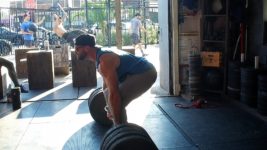
The deadlift is a simple movement. Picking something up off the floor can wreak havoc on a body if not done well. While the previous statement is true, it is also true that if done correctly and maintaining form, you could put 10,000 pounds on the bar, pull as hard as you want, and not get hurt. One thing is certain: everyone can learn. But, we all do so in different ways. Today I want to attempt to pull apart the deadlift in a different way to maybe give someone more clarity on this movement.
While the deadlift routinely gets credit at a posterior chain builder, and rightly so, it is actually a tremendous trunk building movement. During the deadlift the trunk is rigid, or isometrically contracted, and in a neutral position. Let’s say the movement has three parts: the set up, the execution, and the finish. A successful and safe deadlift will result in no movement of the spine during the execution of the movement. This, of course, is excluding higher level competitive dead lifters that may subscribe to a different execution strategy. This entry is targeted to those learning the mechanics of the movement.
The setup, in this example, includes two steps while the athlete is addressing the bar. Imagine an athlete standing at the bar with their feet underneath their hips. The first step is anchoring. It is your job as an athlete to anchor yourself to this bar you are going to stand up. The first step is the hands. Pick your grip and pull against the bar. Pulling against the bar is done by pulling from your shoulder. Elbow stays extended and does not bend during the lift. Using your lats to pull your shoulder blades and hips down, and set your back into a flat position. Your arms are just ropes. The knot at the end of the rope is your grip. Your rope is anchored through your shoulder to your hips, which are ever so conveniently connected by your tensioned lat muscle. The lat runs from your humorous (upper arm bone) down to your thoracic vertebra (mid-back) and fascia that attaches to your pelvis. If the science speak doesn’t hit home, know that you basically have a shell of muscle that keeps you connected to the bar. The engine that drives the bar is your hips, the attachment is your shoulders. The connection is your trunk. Your lats are super important in the rigidity of your trunk, as well as your abs.
After you anchor yourself to the bar, there is some serious tensioning that needs to go down. By tensioning I am talking about pulling against the bar with your shoulder, and pushing your feet into the floor. What you feel when you do this is tension through your whole body. Your body will feel like one big muscle. This is done while simultaneously taking a big breath and contracting your abs. Think of trying to wedge yourself between the bar and the floor. Your abs should be ready to take a punch.Now, drive your feet into the floor, and stand.
Cheers to safe and happy deadlifting. I hope this provided a new perspective for some of you.
Danny Lesslie
@dannylesslie
2/7/17 WOD
3-3-3-3-3
Conventional Deadlift 2” Block
EMOM 10
1 Back Squat (75%)

